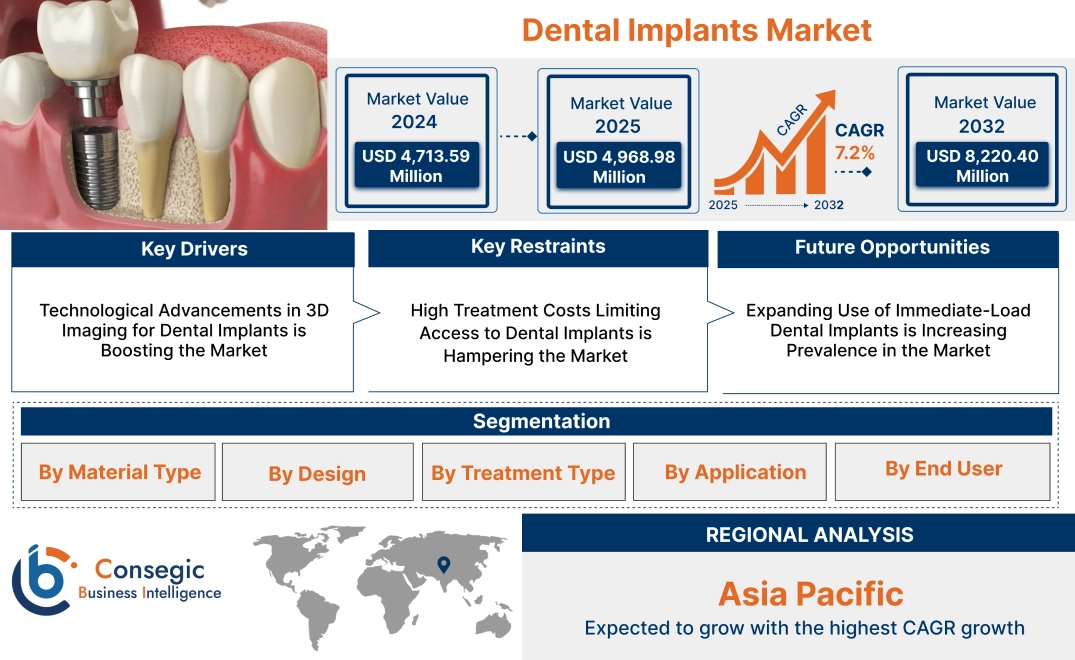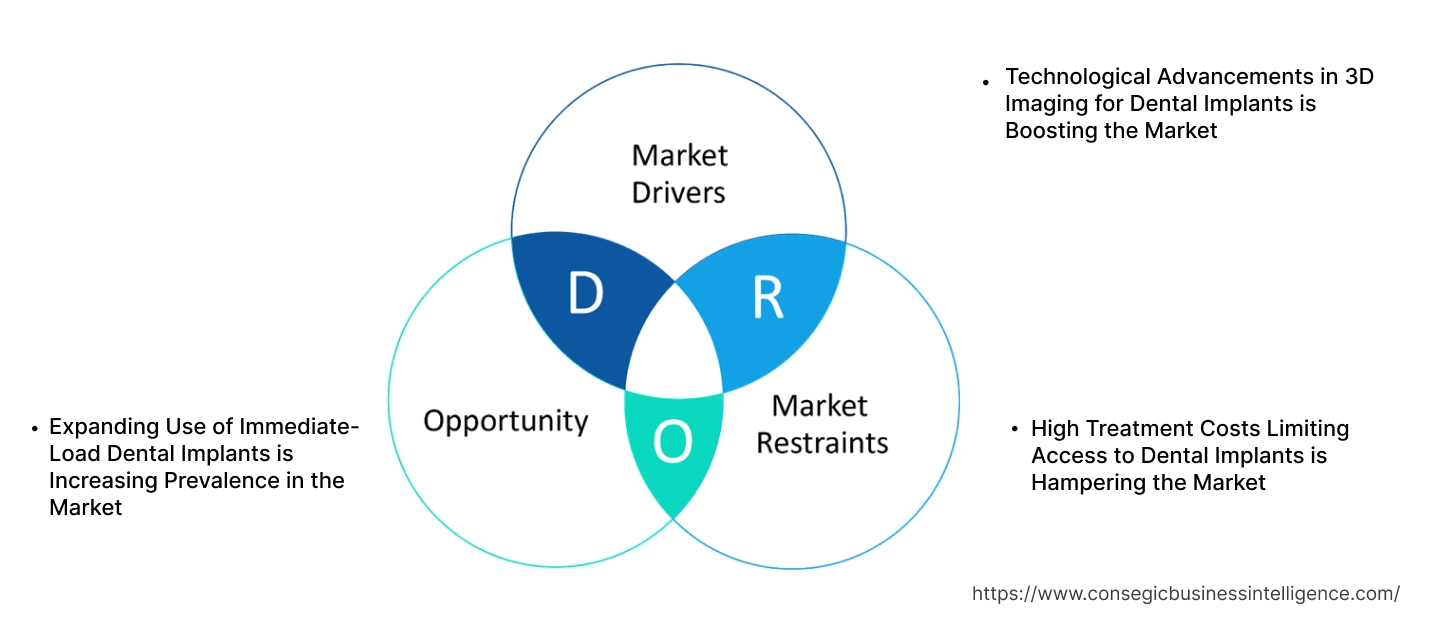- Summary
- Table Of Content
- Methodology
Dental Implants Market Size:
Dental Implants Market size is estimated to reach over USD 8,220.40 Million by 2032 from a value of USD 4,713.59 Million in 2024 and is projected to grow by USD 4,968.98 Million in 2025, growing at a CAGR of 7.2% from 2025 to 2032.
Dental Implants Market Scope & Overview:
The dental implants are artificial tooth roots surgically embedded into the jawbone, providing a stable foundation for prosthetic teeth like crowns and dentures. Constructed from biocompatible materials such as titanium or zirconia, dental implants offer durability, resistance to corrosion, and compatibility with natural bone tissue, allowing for effective Osseointegration, which ensures stability and longevity. Common applications include single and multiple tooth replacements, full-mouth restorations, and complex cosmetic or reconstructive dental procedures where aesthetic and functional restoration is essential. End users primarily include dental clinics, hospitals, and specialized dental centers, along with the healthcare and cosmetic industry focused on oral rehabilitation and enhanced dental aesthetics. Additionally, dental tourism has emerged as a significant contributor, with patients seeking affordable, quality implant procedures internationally.
Key Drivers:
Technological Advancements in 3D Imaging for Dental Implants is Boosting the Market
Technological advancements in 3D imaging are significantly enhancing the accuracy and efficiency of dental implant procedures. 3D imaging allows for precise mapping of the jawbone structure and the identification of potential complications before the surgical process begins. This level of detail enables implant specialists to plan surgeries with greater confidence, minimizing the risk of complications and improving overall patient outcomes. Furthermore, it enhances the ability to place implants in the most optimal positions for durability and function. For example, 3D cone-beam computed tomography (CBCT) technology provides detailed three-dimensional images of the jaw and surrounding structures, allowing practitioners to visualize bone density and determine the most suitable implant size and placement. This technology can reduce the number of visits required for implant placement, leading to shorter treatment times and less discomfort for patients. The enhanced precision provided by 3D imaging directly contributes to improved implant success rates and greater patient satisfaction.
In conclusion, the integration of 3D imaging in the dental implants market is a crucial driver, as it enhances treatment planning, reduces errors, and contributes to more successful outcomes, making dental implants more accessible and reliable for patients.
Key Restraints:
High Treatment Costs Limiting Access to Dental Implants is Hampering the Market
One of the primary restraints in the dental implants market is the high cost associated with the procedure, which often includes the implant, surgery, consultations, and post-operative care. For many patients, particularly in developing regions or those without adequate dental insurance coverage, the financial burden can be prohibitive. The cost of dental implants is significantly higher than other traditional dental restoration options, such as dentures or bridges, making them less accessible to a wider demographic.
For instance, in countries like India or certain parts of Africa, where the average income is lower and insurance coverage for dental procedures is minimal, patients may delay or avoid opting for implants due to the cost. The price barrier not only limits the number of individuals who can afford treatment but also contributes to the slower adoption of advanced dental technologies in these regions. This restricts the growth potential of the market in these areas.
In conclusion, the high treatment costs of dental implants act as a significant restraint by limiting the affordability and accessibility of these solutions, especially for lower-income populations, ultimately hindering dental implants market expansion in certain regions.
Future Opportunities :
Expanding Use of Immediate-Load Dental Implants is Increasing Prevalence in the Market
A promising future dental implants market opportunity lies in the growing adoption of immediate-load dental implants, which allow patients to receive a functioning tooth on the same day as the implant procedure. This innovation addresses the common challenge of extended recovery times associated with traditional implants, where patients often need to wait several months for the implant to properly fuse with the bone before a crown can be placed.
Immediate-load implants use advanced techniques and materials that allow for the placement of the implant and a temporary tooth restoration in a single visit, significantly reducing the total treatment time. This not only enhances patient convenience but also improves overall patient satisfaction by minimizing the wait time for a functional tooth.
For example, in clinical settings, immediate-load implants are being increasingly adopted for patients requiring single-tooth replacements or full-arch restorations, as they offer faster results without compromising the success rate of the implant. This innovation presents a key opportunity for dental professionals to attract more patients who seek quick solutions to tooth loss.
In conclusion, the rise of immediate-load dental implants is an exciting dental implants market opportunity, as it not only shortens recovery times and improves patient satisfaction but also positions dental implants as a more attractive and accessible option for those looking for faster and more effective dental restoration solutions.
Dental Implants Market Segmental Analysis :
By Material Type:
Based on material type, the market is segmented into titanium, zirconium, and others.
The titanium segment accounted for the largest revenue share of 54.37% in 2024.
- Titanium implants are the most widely used in the dental industry due to their excellent biocompatibility, high strength, and proven long-term success rates.
- Titanium's unique property of osseointegration, where the implant naturally fuses with the bone, has made it the preferred choice for both single-tooth and full-arch restorations.
- The material’s durability and resistance to corrosion also make it ideal for complex dental surgeries, ensuring stability and longevity.
- With ongoing advancements in surface treatment technologies, such as plasma spraying and anodization, the performance of titanium implants continues to improve, solidifying its dominance as per the market analysis.
- Titanium leads the market due to its superior biocompatibility, proven success rates, and advancements in surface treatment technologies that enhance osseointegration and implant durability.
The zirconium segment is anticipated to register the fastest CAGR during the forecast period.
- Zirconium implants, particularly zirconia-based ceramics, are gaining popularity due to their aesthetic appeal and metal-free composition, making them ideal for patients with metal allergies or those seeking natural-looking restorations.
- Zirconium offers high strength and fracture resistance, with a natural tooth-like color that makes it particularly favored in anterior (front tooth) restorations.
- The growing trends for aesthetically pleasing dental solutions and the increasing adoption of metal-free implants in cosmetic dentistry are driving the rapid trends of zirconium implants.
- Zirconium implants are expected to grow rapidly, driven by their aesthetic advantages and suitability for patients seeking metal-free, natural-looking dental solutions.
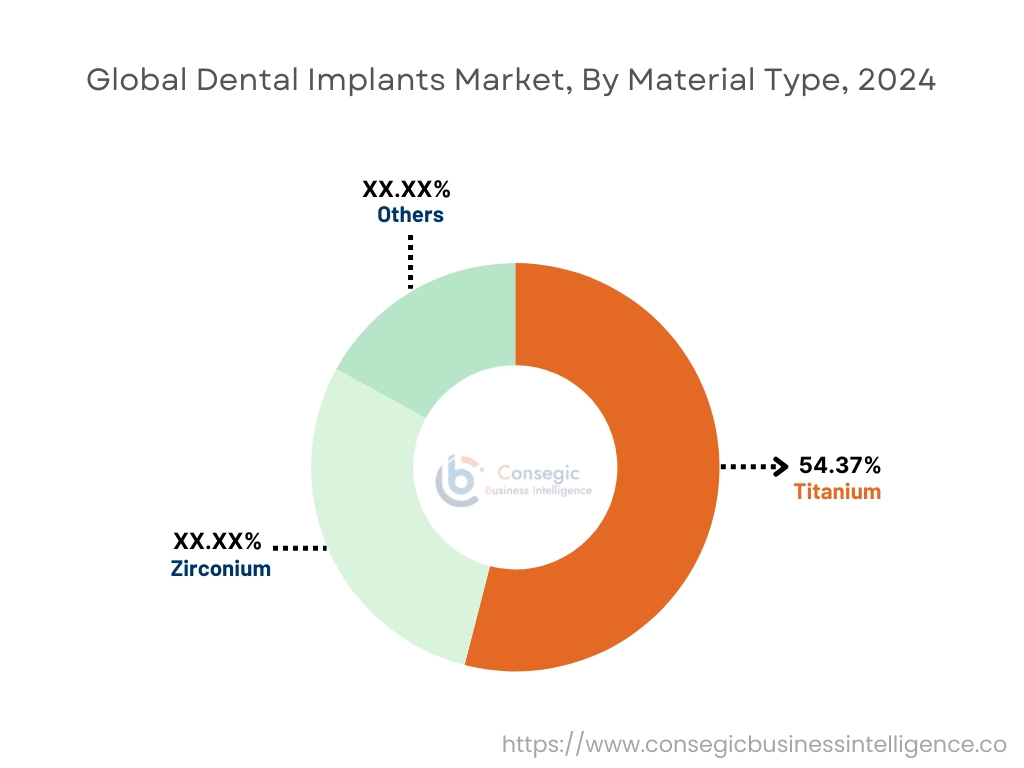
By Design:
Based on design, the market is segmented into tapered implants and parallel-walled implants.
The tapered implants segment accounted for the largest revenue of the Dental Implants Market share in 2024.
- Tapered implants mimic the natural shape of tooth roots, providing better primary stability, especially in cases of immediate implant placement or low bone density.
- Their conical shape allows for easier insertion into narrower bone ridges, enhancing the stability of the implant during the healing process.
- Tapered implants are increasingly preferred in complex cases, such as those involving immediate loading, where initial stability is crucial.
- The advancements in surface coatings and thread designs that enhance bone-to-implant contact have further propelled the adoption of tapered implants.
- Tapered implants dominate the market due to their superior primary stability and ability to accommodate various bone conditions, making them a preferred choice in complex and immediate loading cases.
The parallel-walled implants segment is expected to show steady growth during the forecast period.
- Parallel-walled implants are known for their uniform design, which provides even load distribution along the entire length of the implant.
- This design is particularly effective in dense bone areas and offers predictable outcomes in standard implant procedures.
- Parallel-walled implants are often used in cases where bone density is sufficient, ensuring strong bone-to-implant integration.
- Although their adoption is not as rapid as tapered implants, they remain a reliable choice for conventional implant surgeries, particularly in patients with healthy bone structures.
- Parallel-walled implants continue to see steady demand, especially in cases with sufficient bone density, due to their even load distribution and predictable integration outcomes.
By Treatment Type:
Based on treatment type, the market is segmented into endosteal implants, subperiosteal implants, and zygomatic implants.
The endosteal implants segment accounted for the largest revenue of the Dental Implants Market share in 2024.
- Endosteal implants are the most common type of dental implants, placed directly into the jawbone.
- They are typically shaped like screws, cylinders, or blades and are favored for their high success rates and versatility in different restoration procedures.
- The growing prevalence of tooth loss, coupled with advancements in implant materials and techniques, has increased the adoption of endosteal implants across all patient demographics.
- The segment’s dominance is further supported by its suitability for a wide range of applications, from single-tooth to full-arch restorations.
- Endosteal implants lead the market, driven by their high success rates, versatility, and widespread use in various restoration procedures.
The zygomatic implants segment is anticipated to register the fastest CAGR during the forecast period.
- Zygomatic implants are used in patients with severe bone loss in the upper jaw, where traditional implants may not be feasible.
- These implants are anchored in the zygomatic bone (cheekbone), providing a strong foundation without the need for bone grafting.
- The increasing number of patients seeking full-arch restorations who have insufficient maxillary bone volume is driving the dental implants market trends for zygomatic implants.
- Innovations in implant designs and minimally invasive surgical techniques are further boosting the adoption of zygomatic implants.
- Zygomatic implants are expected to grow rapidly due to their ability to provide a stable foundation in patients with severe maxillary bone loss, eliminating the need for complex bone grafting procedures.
By Application:
Based on application, the market is segmented into single-tooth restoration, multiple-tooth restoration, and full-arch restoration.
The full-arch restoration segment accounted for the largest revenue share in 2024.
- Full-arch restoration involves replacing an entire arch of teeth, often using implant-supported dentures or bridges.
- This approach is popular among patients with severe tooth loss or edentulism, offering a stable and long-lasting solution.
- Full-arch restorations provide significant improvements in functionality, aesthetics, and patient comfort compared to traditional dentures.
- The rising trends for comprehensive and long-term dental solutions, combined with the increasing availability of advanced techniques such as All-on-4 implants, support the trends of the full-arch restoration segment.
- Full-arch restoration leads the market, driven by its effectiveness in addressing severe tooth loss and the growing adoption of advanced implant-supported solutions like All-on-4.
The single-tooth restoration segment is anticipated to register steady growth during the forecast period.
- Single-tooth restoration is a common procedure for patients who have lost a single tooth due to trauma, decay, or periodontal disease.
- This application is highly favored for its minimal invasiveness and the ability to restore functionality and aesthetics without affecting adjacent teeth.
- The increasing incidence of single-tooth loss and the growing preference for implant-based solutions over traditional bridges are contributing to the steady rise in this segment.
- Single-tooth restoration continues to see steady growth, driven by its minimally invasive nature and the rising preference for implant-based replacements in cases of isolated tooth loss.
By End-User:
Based on end users, the market is segmented into hospitals, dental clinics, research institutions, and others.
The dental clinics segment accounted for the largest revenue share in 2024.
- Dental clinics are the primary providers of implant procedures due to their specialized expertise and the availability of advanced dental technologies.
- The increasing number of specialized implantology centers and the growing preference for outpatient settings for dental procedures contribute to the dominance of this segment.
- Dental clinics offer personalized care and a wide range of implant options, making them the preferred choice for patients seeking both cosmetic and functional dental restorations.
- Dental clinics dominate the market, driven by their specialization in implantology, advanced technologies, and the growing preference for outpatient dental care.
The hospital segment is anticipated to register the fastest CAGR during the forecast period.
- Hospitals are increasingly adopting advanced dental implant procedures, particularly for complex cases that require multidisciplinary care.
- The integration of dental departments within hospital settings and the availability of comprehensive diagnostic and surgical facilities are driving the adoption of dental implants in hospitals.
- The dental implants market trends toward hospital-based implant procedures are also influenced by the increasing advancement for full-mouth reconstructions and cases involving severe bone loss.
- Hospitals are expected to grow rapidly due to their ability to handle complex dental implant cases and the availability of comprehensive surgical facilities.
Regional Analysis:
The regions covered are North America, Europe, Asia Pacific, the Middle East and Africa, and Latin America.
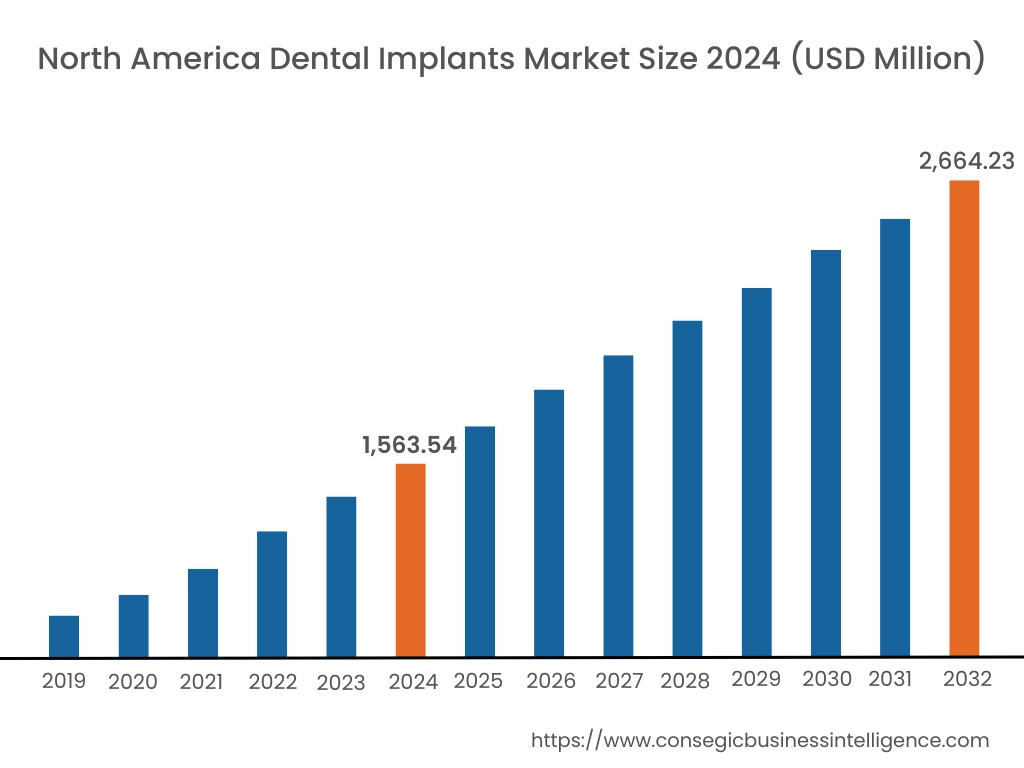
In 2024, North America was valued at USD 1,563.54 Million and is expected to reach USD 2,664.23 Million in 2032. In North America, the U.S. accounted for the highest share of 68.85% during the base year of 2024. The market in North America is driven by increasing awareness of aesthetic dental procedures and the growing demand for cosmetic and restorative dental treatments. The region benefits from advanced dental technologies such as 3D imaging and digital surgery, which improve treatment outcomes and precision. The aging population in the U.S. and Canada, combined with rising disposable incomes and some insurance coverage for dental implants, further fuels dental implants market demand. As a result, North America remains a leading market for dental implants, with strong advancements in both functional and aesthetic dental procedures.
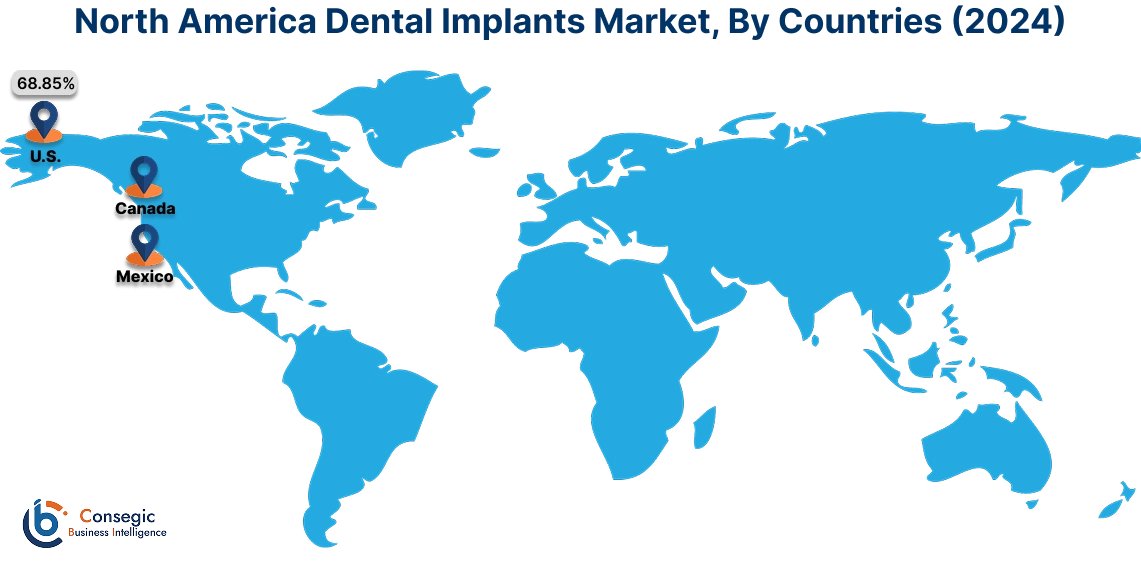
In Asia Pacific, the market is experiencing the fastest growth with a CAGR of 7.6% over the forecast period. Asia Pacific is experiencing rapid dental implants market growth, driven by economic development, a growing middle class, and rising awareness of oral health. The analysis shows countries like China, Japan, and India are witnessing increasing trends for dental implants, fueled by higher disposable incomes and the popularity of cosmetic dentistry. In addition, technological advancements and the availability of affordable dental care in emerging markets contribute to market expansion. Dental tourism is also a significant factor, with countries like Thailand and India attracting international patients. The region is expected to register the fastest growth in the market due to these favorable conditions.
Europe’s dental implants market analysis displays it is characterized by high awareness of oral health, technological adoption, and an aging population. Countries like Germany, the UK, and France are witnessing strong demand for implants, driven by both aesthetic and functional needs. Technological advancements, such as CAD/CAM systems and computer-guided surgery, are also pushing the dental implants market growth. The market analysis shows region's aging demographic is a significant factor, as older adults increasingly seek dental implants to address tooth loss. With a well-established healthcare system and high disposable incomes, Europe is expected to maintain steady market growth, with dental implants being a preferred solution for oral health restoration.
In Latin America, the market is expanding due to the rise in dental tourism, particularly in countries like Mexico and Brazil, where more affordable dental care attracts international patients. The dental implants market analysis shows the growing middle-class population in the region is driving trends for advanced dental treatments, including implants, as consumers are becoming more aware of their benefits. Additionally, government initiatives aimed at improving healthcare access and rising disposable incomes contribute to the market trends. Latin America is poised for a rapid surge, particularly in the context of dental tourism and increasing demand for cosmetic dentistry.
The market in Africa and the Middle East is growing at different paces. In Africa, urban areas like South Africa are seeing increased dental implants market demand for dental implants due to rising awareness and a growing middle class, though access remains limited in rural areas. In contrast, the Middle East is experiencing a rapid surge, driven by affluent populations in countries like the UAE and Saudi Arabia seeking both functional and cosmetic dental procedures. Investments in healthcare infrastructure and the rise of medical tourism, especially in cities like Dubai, are also contributing to the region's dental implants market expansion.
Top Key Players & Market Share Insights:
The dental implants market is highly competitive with major players providing products and services to the national and international markets. Key players are adopting several strategies in research and development (R&D), product innovation, and end-user launches to hold a Dental Implants Market. Key players in the dental implant industry include -
- Institut Straumann AG (Switzerland)
- Dentsply Sirona Inc. (United States)
- Dentium Co., Ltd. (South Korea)
- Bicon, LLC (United States)
- Thommen Medical AG (Switzerland)
- Zimmer Biomet Holdings, Inc. (United States)
- Osstem Implant Co., Ltd. (South Korea)
- BioHorizons IPH, Inc. (United States)
- CeraRoot SL (Spain)
- Envista Holdings Corporation (United States)
Recent Industry Developments :
Approvals:
- In December 2021, Health Canada approved the first additively manufactured medical implant in the country—a customized 3D-printed mandibular plate. Crafted from biocompatible titanium grade 23 (Ti6Al4V-ELI), the implant was produced at the 3D Anatomical Construction Laboratory within Investissement Québec – CRIQ’s facilities. This approval marks a significant advancement in the use of 3D printing in dental implants, allowing for more tailored, accurate solutions in jaw reconstruction.
Dental Implants Market Report Insights :
| Report Attributes | Report Details |
| Study Timeline | 2019-2032 |
| Market Size in 2032 | USD 8,220.40 Million |
| CAGR (2025-2032) | 7.2% |
| By Material Type |
|
| By Design |
|
| By Treatment Type |
|
| By Application |
|
| By End-User |
|
| By Region |
|
| Key Players |
|
| North America | U.S. Canada Mexico |
| Europe | U.K. Germany France Spain Italy Russia Benelux Rest of Europe |
| APAC | China South Korea Japan India Australia ASEAN Rest of Asia-Pacific |
| Middle East and Africa | GCC Turkey South Africa Rest of MEA |
| LATAM | Brazil Argentina Chile Rest of LATAM |
| Report Coverage |
|
Key Questions Answered in the Report
How big is the Dental Implants Market? +
Dental Implants Market size is estimated to reach over USD 8,220.40 Million by 2032 from a value of USD 4,713.59 Million in 2024 and is projected to grow by USD 4,968.98 Million in 2025, growing at a CAGR of 7.2% from 2025 to 2032.
What materials are commonly used for dental implants? +
Dental implants are primarily made from biocompatible materials like titanium and zirconia.
Which region is leading the Dental Implants Market? +
North America is currently leading the Dental Implants Market due to high awareness and advanced dental care technologies.
What are the key challenges in the Dental Implants Market? +
The high cost of implants and lack of awareness in developing regions are the major challenges faced by the market.
What is the future outlook for the Dental Implants Market? +
The Dental Implants Market is expected to grow steadily, driven by technological advancements, increasing dental tourism, and rising demand for cosmetic procedures.
